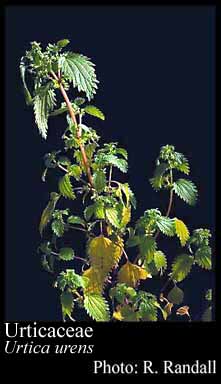- Reference
- Gen.Pl. [Jussieu] 400 (1789)
- Name Status
- Current

Scientific Description
Common name. Nettle Family.
Habit and leaf form. Shrubs, lianas, and herbs, or trees (a few). Plants with neither basal nor terminal concentrations of leaves. Young stems often tetragonal. Self supporting, or climbing. Mesophytic. Leaves small to large; alternate, or opposite; when alternate, spiral; petiolate, or sessile; non-sheathing; simple. Leaf blades entire (usually), or dissected (rarely); conspicuously asymmetric, or not conspicuously asymmetric; when dissected, palmately lobed; pinnately veined, or palmately veined; cross-venulate. Leaves with stipules (usually), or without stipules (e.g. Parietaria). Stipules interpetiolar, or intrapetiolar; free of one another, or concrescent. Leaf blade margins entire, or serrate, or dentate. Leaves without a persistent basal meristem. Domatia recorded (two genera); represented by pockets. Leaf anatomy. Urticating hairs present (Urticeae), or absent. Stem anatomy. Nodes tri-lacunar. Secondary thickening developing from a conventional cambial ring (usually), or anomalous (Myriocarpa); from a single cambial ring.
Reproductive type, pollination. Fertile flowers functionally male and functionally female, or functionally male, or functionally female, or hermaphrodite, functionally male, and functionally female. Unisexual flowers present. Plants monoecious, or dioecious, or polygamomonoecious. Female flowers with staminodes (scalelike), or without staminodes. Male flowers with pistillodes, or without pistillodes. Anemophilous. Pollination mechanism conspicuously specialized (the filaments reflexing violently).
Inflorescence and flower features. Flowers solitary (rarely), or aggregated in ‘inflorescences’. The terminal inflorescence unit cymose. Inflorescences axillary; loose, glomerate, spiked, racemed, panicled or capitate cymes, the flowers often condensed into heads etc., or sometimes crowded on a common receptacle which may be concave or convex; with involucral bracts, or without involucral bracts. Flowers bracteate, or ebracteate; minute, or small; regular; (3–)4–5(–6) merous. Hypogynous disk absent. Perianth sepaline, or vestigial to absent (sometimes, in female flowers); (2–)4–5(–6); 1 -whorled; free, or joined; persistent; accrescent (often), or non-accrescent. Calyx (the perianth being thus interpreted) (2–)4–5(–6) (males), or 3–5 (when present, in females); 1 -whorled; polysepalous, or gamosepalous; imbricate, or valvate; regular; persistent; accrescent, or non-accrescent. Fertile stamens present, or absent (female flowers). Androecium (2–)4–5(–6). Androecial members free of the perianth; free of one another; 1 -whorled. Androecium exclusively of fertile stamens. Stamens (3–)4–5(–6); isomerous with the perianth; oppositisepalous; inflexed in bud (uncoiling elastically); filantherous (the filaments usually wrinkled). Anthers dorsifixed; dehiscing via longitudinal slits; introrse; tetrasporangiate. Fertile gynoecium present, or absent (male flowers). Gynoecium ostensibly 1 carpelled (i.e. with no obvious evidence of more than one carpel). The pistil 1 celled. Carpels reduced in number relative to the perianth. Gynoecium monomerous (ostensibly), or syncarpous (supposedly, theoretically); of one carpel (at least, usually with no evidence of syncarpy), or synstylovarious to eu-syncarpous (theoretically); superior (usually), or partly inferior (Pipturus etc). Carpel (if treated as monomeric) shortly stylate, or non-stylate; apically stigmatic; 1 ovuled. Placentation basal. Ovary unilocular; if recognised as syncarpous, 1 locular. Gynoecium stylate, or non-stylate to stylate. Stigmas dry type; papillate; Group II type. Placentation if recognised as syncarpous, basal. Ovules in the single cavity 1; funicled, or sessile; ascending; non-arillate; orthotropous to hemianatropous.
Fruit and seed features. Fruit fleshy, or non-fleshy. The fruiting carpel (treated as monomeric) indehiscent; an achene, or nucular, or drupaceous. Fruit if recognised as syncarpous, indehiscent; achene-like, or a nut, or a drupe (rarely); 1 seeded. Seeds scantily endospermic, or non-endospermic. Endosperm oily, or not oily. Cotyledons 2. Embryo achlorophyllous (2/2); straight.
Physiology, biochemistry. Aluminium accumulation not found. Photosynthetic pathway: C3.
Geography, cytology, number of species. World distribution: cosmopolitan except frigid zones. X = 6–14. 550 species.
Economic uses, etc. Commercial cordage fibre (ramie) is obtained from Boehmeria nivea, a few (e.g. Pilea spp.) are grown as novelties, and nettles (Urtica spp.) constitute edible and quite palatable greens.